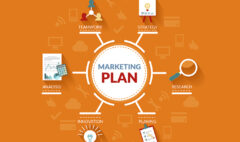2023 FAQs: You need to know about Digital Marketing
August 30, 2023 2023-12-15 4:342023 FAQs: You need to know about Digital Marketing
2023 FAQs: You need to know about Digital Marketing
Digital marketing, a booming online sector, is set to dominate, offering abundant job opportunities in the years ahead. To help you boost your confidence and prepare you well to ace your interview, we have compiled a list of the top Digital Marketing interview questions, for both freshers and experienced candidates. The questions have been categorized in the following sections-
Commonly asked Digital Marketing Interview Questions
Q1. How can you categorize Digital marketing?
| Inbound Marketing | Outbound Marketing |
| Pulls in interested costumers | Pushes regardless of interest |
| Written according to the consumer’s needs | Written according to the product’s needs |
| A part of content consumption | Disrupts content consumption |
| Natural habitat: blogs, social media, search, influencer marketing, opt-in emails. | Natural habitat: display ads, telemarketer scripts, magazines, TV ads, billboards. |
Q2. Explain Digital marketing?
Ans: Digital marketing is all about the tactics for brand marketing via online channels. It includes various techniques like SEO, SEM, Link building, Email marketing, PPC, Affiliate Marketing, etc.
Q3. What are the different types of Digital Marketing?
Ans: Different Digital Marketing aspects –
- Search Engine Optimization (SEO)
- Search Engine Marketing (SEM)
- Content Marketing
- Email Marketing
- Social Media Marketing
- E-commerce Marketing
Q4. What are the most effective ways to increase traffic to your website?
Ans: The most popular and effective ways to increase traffic to your website are-
- Paid search
- Display advertising
- Content marketing
- Writing crisp headlines
- SEO activities
- Content optimization
- Targeting long-tail keywords
- Guest blogging
- Seeking referral traffic
- Posting content on LinkedIn
- Linking Internally
- Email marketing
Q5. Define SEO.
Ans: SEO or Search Engine Optimization is the process of increasing the quantity and quality of website traffic by increasing the visibility to users of a web search engine. SEO is the practice of getting traffic from the organic, editorial or natural search results on search engines.
Q6. Explain keywords in Digital marketing? How important is it for SEO?
Ans: A keyword is the most significant and fundamental element of Search Engine Optimization. Users use keywords to search for a product or service on the internet.
Keywords are the core of all your SEO efforts. They are crucial for better rankings in the search engine result pages (SERPs). It is really important to make your website SEO optimized for keywords that are relevant to your business. This would help your website’s pages to rank higher in search engines which makes it easier for people to find your website.
Q7. What are the key areas where you can use keywords to optimize your site ranking?
Ans: For better page ranking, keywords can be used in the following areas-
- Website URL
- Website Title
- Meta tag
- Web page content
- Body text
- Headlines
Q8. What are the different types of SEO?
Ans: White hat SEO – It is the most popular SEO technique that utilizes methods and techniques to improve search engine rankings of a site which do not run afoul of search engine guidelines. White hat SEO uses techniques like high-quality content, link acquisition, website HTML optimization, and restructuring. With White hat SEO, you can expect a long-lasting growth in your rankings.
Black hat SEO – It exploits the various weaknesses in the search engines algorithms to get high rankings. The Black hat SEO is not in accordance with the SEO guidelines set by search engines. Some of the black hat SEO techniques are keyword stuffing, link spam, hidden text, hidden link. Using these techniques, you can expect unpredictable, quick but short-lasting growth in rankings.
Grey hat SEO – Grey hat SEO is neither black nor white, it rather combines both. It is a transformation from black SEO techniques to white SEO techniques and from white SEO techniques to black SEO techniques.
Q9. What are on-page and off-page optimization?
Ans:
| On-page | Off-page |
| It refers to factors that you can optimize on your own website to grow traffic. | Of-page SEO is all about your online reputation. It includes acquiring backlinks for your page from the authority sites in your niche. |
| The main components involved in on-page optimization are – Title of the page, Meta description tag, Optimized Image with alt tags, URL structure, High-quality content, Optimized internal links. | The main components involved in off-page optimization are – Acquiring Backlinks, Leveraging social interaction with your site, Promote your content via social channels, Add social book markings, Guest Blogging |
Q10. Name some useful Digital Marketing tools.
Ans:
- Keyword Discovery
- RankWatch
- Moz
- Alexa Ranking
- Google Analytics
- Crazy Egg Heatmaps
- Favicon Generator
- XML Sitemap Generator
- SubmitExpress Link Popularity
- Digital Point Keyword Tracker
- Google Trends
- Google Keyword Planner
- Kissmetrics
- SEMrush
- Ahrefs
- Buzzsumo
- AdExpresso
- Buffer App
- MailChimp
- Unbounce
- Hasoffers
Q11. Explain PPC or Pay Per Click advertising?
Ans: In Pay Per Click advertising, advertisers pay the publisher (website owner or a host of the website) when the ad is clicked.
Q12. Explain Google Adwords.
Ans: Google AdWords is an online advertising service, by Google, to help marketers reach their customers instantly. Businesses use this service to display ads on Google and its advertising network. It is the most famous Pay-Per-Click advertising system in the world. Adwords allow businesses to set a budget for ads and the payments happen when people click on the ads. Google Adwords service focuses on keywords.
Q13. Explain Google AdWords Remarketing.
Ans: Google AdWords Remarketing is referred to a targeted marketing strategy that assists the marketers to reach out to people who visited their site previously but did not complete the purchase. Remarketing helps target the right people at the right time with the right ad. It helps increase conversion rates as the past site visitors may already be familiar with your brand and turn into prospective customers easily.
Q14. What is the limit for the characters in Adwords Ads?
Ans: The headlines and sub-headlines should not be more than 30 characters and the descriptions should be within 90 characters.
Q15. Name some of the Google AdWords ad extensions?
Ans:
- Call extensions
- Callout Extension
- Promote extension
- Structured snippet extension
- Sitelink extension
- Affiliate location extension
- App extension
Q16. What can be the ideal approach for effective PPC campaigns?
Ans:
- Add more PPC keywords to expand the reach
- Split ads into smaller segments to have a better Click Through Rate (CTR)
- Review non-performing PPC keywords
- Refine landing pages to align with search queries
- Improve campaign relevancy by adding negative keywords
Q17. What can you do to improve your conversion rates?
Ans: Increased conversion rates can be achieved by testing different website elements, especially on a landing page. Also, you can experiment with functionality, layout, and style on landing pages.
Q18. Explain a responsive web design?
Ans: Responsive web design makes web pages perform well on different devices like desktop, mobile, and tablet. It ensures that the user has a great viewing experience no matter what device they use to access your website. The practice of a responsive design consists of a mix of flexible layouts, images, grids, and the use of CSS media queries.
Q19. What is the difference between direct marketing and branding?
Ans: In the case of branding, the advertiser has to expose his brand to websites and applications that have a higher audience reach. The most known methods are YouTube ads, display target ads, custom ads, and remarketing.
In the case of direct marketing, the advertiser is interested mostly in establishing communication with his target audience through different mediums like emails, mails, pamphlets, catalogs, flyers, etc.
The basic difference between them is that branding is done to build awareness, whereas direct marketing help companies to reach out to their customers directly.
Q20. What are the limitations of Online Marketing?
Ans: Intense Competition: Since online marketing is easily accessible and cost-effective, it has become a preferred method for most of the brands. Therefore, it is an uphill task to get noticed amongst such intense competition.
It can get overwhelming: There is so much information and data and an onslaught of tools that it’s easy to get overwhelmed and get confused. It takes a lot of practice and experience to get your head around all of it.
Analytics is only as good its user: There is analytics for everything but you can’t do anything with plain data unless you know how to read and make use of it. It can become misleading sometimes and you can get stuck in chasing vain metrics and burning cash at the wrong places.
Q21. What is the difference between SEO and SEM?
Ans: SEO enables your website to appear in search engine result pages while SEM is search engine marketing to purchase a space in search engine result page
Q22. What is the use of anchor tag in SEO?
Ans: The anchor text is the visible, clickable text in a hyperlink. The words contained in the anchor text can determine the page ranking in search engines.
Q23. Name some PPC (Pay-Per-Click) tools?
Ans:
- SEMrush
- Optimizely
- Unbounce
- Keyword planner
- Adwords Editor
- AdWords Wrapper
Q24. How can you use social media for marketing?
Ans: Social media marketing involves creating and sharing content on social media channels to achieve your marketing and branding goals. It includes different activities like posting images, videos, and other content that drives audience engagement.
Social media marketing can help you by increasing website traffic, building conversions, increasing brand awareness and improving communication and interaction with target audiences.
Q25. What do you know about Email Marketing?
Ans: Email marketing is a highly effective Digital Marketing strategy of sending emails to target leads and customers. Effective marketing emails convert leads into customers and turn one-time buyers into loyal fans.
Q26. What is Content Marketing?
Ans: Content marketing is a strategic approach focused on creating and distributing relevant, valuable, and consistent content to attract and retain a clearly-defined audience and drive profitable customer action. The key reasons for enterprises to use content marketing are –
- Increased sales
- Cost savings
- Better customers who have more loyalty
Q27. Why is online marketing preferred more than offline marketing?
Ans: Online marketing is preferred over offline marketing for the following reasons –
- You can tap a larger audience and expand geographically easily
- Information is immediately available online
- Interact with customers easier and get in touch faster
- Better tracking
Q28. How should companies measure Social Media Marketing Success?
Ans: Success is measured by utilizing different metrics – traffic, leads, and clients. Counting the number of followers on your channels can help you know your social media reach. The factors that define success is how many people social media drives to your website, how many of them are qualified leads, and how many of them become costumers.
Q29. What is AMP?
Ans: AMP is short for Accelerated Mobile Pages. It is a project from Twitter and Google to make fast mobile pages. AMP is an open-source library that helps create a lightweight and fast loading web page. It enables marketers and publishers to create mobile-friendly web pages, which can be supported at different platforms and is compatible with all types of browsers.
Q30. What KPIs do you use in social media reporting?
Ans: The popular key performance indicators in social media reporting are –
- Reach
- Engagement
- Leads
- Conversions
- Likes
- Shares
- Traffic data
- Leads
- Active followers
- Brand mentions
Q31. Explain how AdWords work.
Ans: Adwords deal with offering framework. If the offering costs high, your promotion will show up over the Google page. Adwords deals with pay per click which means you pay the sum you have offered if somebody taps on your advertisement because of web seek.
Q32. What are long-tail keywords?
Ans: A long-term word is a keyword phrase containing 4+ words that make the search results more specific. Long-tail keywords get low search traffic, but they rank better than single-word keywords.
Q33. Explain what is the significance of CTR and how do you calculate it?
Ans: CTR represents Click through rate that represents the number of guests visiting your promotion on the website page. The equation for ascertaining CTR = Number of snap/Number of impressions * 100.
Q34. What are the four C’s of Digital Marketing?
Ans:
Customer – Who sees the message
Content – The message customer sees
Context – Why the Customer sees the message.
Conversation – Happens between you and your customer.
Find out our Digital Marketing Course in Top Cities
Q35. What are the 3 ingredients of Digital Marketing?
Ans: The 3 ingredients of Digital Marketing are-
- Traffic
- Insights
- Sale
Q36. Which platform would you prefer to put Job-related advertisements?
Ans: LinkedIn. Since it is usually accessed by professionals and job seekers so your advertisement will reach the required audience.
Q37. Mention some bidding options.
Ans:
- Cost Per Click (CPC)
- Cost Per Thousand Impressions(CPI)
- Cost Per Action/Acquisition (CPA)
Q38. Why should you use YouTube for Digital Marketing?
Ans: With YouTube, you can present a better picture of the brand by creating interesting videos, which can help boost SEO traffic, expand social reach, create brand awareness, and improve the ROI.
Q39. How can you drive digital traffic to our site immediately?
Ans: Leveraging social media with posts that link back to your site is one key way to funnel traffic to your website within a shorter time frame. Also, posts that include promotions, giveaways, contests, and other engaging, time-sensitive material can be effective. Additionally, generating leads through engagement in online public relations – such as answering queries where you function as a subject expert, or writing a press release for online distribution – are also some strong tactics for quickly amassing traffic.
Q40. What is conversion optimization?
Ans: Conversion optimization is a practice of determining how a website can increase the ratio of visitors to actual customers. A conversion is a site visitor who has taken a desired action rather than simply viewing content and leaving. One way to optimize conversions is to conduct A/B testing, which runs two web pages with altered designs or content to see which yields more conversions.
Q41. How to measure the ROI of any channel?
Ans: To calculate the ROI of a marketing campaign, integrate it into the overall business line calculation. Take the sales growth from the product line, subtract the marketing costs, and divide by the marketing cost.
(Sales Growth – Marketing Cost) / Marketing Cost = ROI
Q42. What is the difference between CPC and EPC?
Ans: CPC is the cost per click, a model used to price many PPC or pay per click advertising models like Google’s AdWords.
EPC (Earnings per 100 clicks) is used within the realm of affiliate marketing to measure average earnings within the 7 day period that an affiliate can expect to earn for every 100 clicks they generate.
Q43. Differentiate between AdWords and AdSense.
Ans: AdWords enables businesses to advertise on Google’s network and AdSense enables publishers to reserve space for AdWords placements on their website. Both AdWords and AdSense work together to complete Google’s advertising network: website owners put up space for Google’s ads (AdSense) and businesses set budgets and ads to display on Advertising network (AdWords).
Q44. Differentiate between No-follow and Do-follow links in SEO.
Ans: No-follow link instructs search engines bots that a hyperlink should not influence the link target’s ranking in the search engine index. It reduces the effectiveness of search engine spams and improves the quality of search engine results.
Do-follow links allow search engines to follow them and reach your website, giving the link juice and a backlink.
Q45. Difference page views and sessions.
Ans: A session is a single visit to your website but pageviews represent the individual time a page on your website is loaded by a User. A single Session can include many Pageviews if a user navigates to any other web pages on your website without leaving.
Digital Marketing Training
DIGITAL MARKETING COURSE
MASTERING GOOGLE ANALYTICS
Q46. What are the WebMaster tools?
Ans: Google Webmaster Tools is a collection of web utilities that help website owners ensure that their site is Google-friendly. These tools have many applications like getting data about incoming search traffic, requesting Google to crawl and index the website, viewing crawl error reports, etc.
Q47. Name 3 email marketing tools.
Ans: Campaign Monitor, Litmus, MailGenius.
Q48. Differentiate between content and context in marketing.
Ans: Content is the material contained within the work that’s available for the audience while context is the positioning of the content, storyline or purpose which provides value to the audience.
Q49. Differentiate between Google Adword and Double Click.
Ans: Google Ads is a paid advertising platform where advertisers participate in an ad auction and their ads are shown based on various metrics while DoubleClick is an ad management platform for publishers to serve ads for advertisers.
Q50. Define a user journey of an online shopper.
Ans: The journey of an online shopper has 4 steps –
- Awareness: When consumers discover your brand.
- Consideration: Potential customers search to check if you offer the products they need.
- Preference: Online shoppers establish a preference in terms of which website they want to purchase from, based on their research.
- Purchase: Customer makes a purchase decision.
.








